Abstract
In this study, we rationally designed a facile stepwise route and successfully synthesized a Co(OH)2/Ni3S2 heterostructure supported on nickel foam (NF) as a binder-free electrode for energy storage. Galvanostatic deposition was first applied to produce uniform Co(OH)2 nanoflakes on NF. Then, Ni3S2 was applied to its surface by potentiostatic deposition to form a Co(OH)2/Ni3S2 heterostructure at room temperature. The added Co(OH)2 not only functions as a practical electrochemically active component but also provides support for the growth of Ni3S2, and the deposition amount of Ni3S2 is controlled by adjusting the electrodeposition duration of Ni3S2. Then, the electrochemical behaviors of the Co(OH)2/Ni3S2 composite can be optimized. A maximum areal specific capacitance (Cs) of 5.73 F cm−2 at 2 mA cm−2 was achieved, and the coulombic efficiency was as high as 94.14%. A capacitance retention of 84.38% was measured after 5000 charge–discharge cycles.
1. Introduction
As the core factor determining the performance of energy storage devices, electrode materials have garnered significant attention [1,2]. Taking supercapacitors as an example, from the perspective of the energy storage mechanism, electrode materials can be divided into two categories: electric double-layer and pseudocapacitance electrode materials [3]. As is known, the latter has been proved to reflect higher specific capacitance (Cs) because the active sites on the surface and near-surface regions of electrode materials can participate in the pseudocapacitive reaction [4]. Therefore, metal-oxide-type electrode materials represented by Ni(OH)2 and Co(OH)2 have attracted the particular attention of researchers, including NiO and Co3O4 obtained by calcinating them and their derivatives nickel sulfide and cobalt sulfide [5,6]. Therefore, in addition to improving traditional preparation routes, such as the hydrothermal method, coprecipitation technology and the electrodeposition process, extensive research has focused on improving the overall electrochemical properties of the materials by regulating the components of electrode materials and optimizing the structure design [7,8]. For example, Satpathy et al. designed a Cu(OH)2 nanobelt/Co(OH)2 nanosheet heterostructure through chemical etching and electrodeposition on copper foil. Cu(OH)2 was selected as the component because of its high electrical conductivity, which can also provide abundant available space for the subsequent deposition of Co(OH)2; this hybrid hydroxide as a binder-free electrode exhibits remarkably higher Cs than single Co(OH)2 [9]. Using similar strategies, our research group prepared a Cu(OH)2/Ni3S2 electrode on copper foam, which achieved a high Cs of 4.85 F cm−2 at 2 mA cm−2 [10]. The choice of the Ni3S2 component is based on the fact that the sulfur in Ni3S2 has a lower electronegativity than the oxygen in the corresponding hydroxide (oxide). Thus, it reflects the advantages of better electrochemical activity and stability [11,12,13]. However, the common problem of the above two examples is that Cu(OH)2 mainly acts as a bridge between the substrate and another component. As a component, Cu(OH)2 has little contribution to the overall electrochemical performance. Finding a candidate to ensure that it can replace the role of Cu(OH)2 and has outstanding pseudocapacitance reaction characteristics has been regarded as the main direction of exploration. Co(OH)2 has become one of the candidates because of its high theoretical Cs and typical flake structure [14,15]. In addition to providing sufficient support for the growth of other components, these flake structures are intertwined with each other, which facilitates the diffusion of electrolyte ions and promotes the efficient contact between the electrolyte and electrode material [16].
Inspired by the above discussion, we designed and constructed a Co(OH)2/Ni3S2 heterostructure on nickel foam, which not only gives full play to the energy storage characteristics of each component but also makes full use of the skeleton support function of Co(OH)2 flakes, which provide sufficient exposed active sites from the perspective of structural design [12,17]. As for the specific preparation route, a three-electrode system was adopted to perform two-step electrodeposition according to previous reports with some modifications; that is, Co(OH)2 nanoflakes were first grown on nickel foam by galvanostatic deposition, and then Ni3S2 was coated on the surface of Co(OH)2 by potentiostatic deposition. An electrodeposition process is a viable option for achieving in situ growth and developing a binder-free electrode. Moreover, its operation process is time-saving, safe and straightforward. In particular, the loading amount of deposited active electrode material can be controlled by adjusting the experimental parameters [18]. In our reaction system, the optimal reaction conditions were identified by adjusting the deposition duration of Ni3S2 and thus delivered the best electrochemical properties of the Co(OH)2/Ni3S2 heterostructure. The present work provides new insight for selecting composite components and structural designs.
2. Materials and Methods
2.1. Materials
Nickel foam (NF, 110 PPI, 1.5 mm thick) was cut into 1 cm×1.5 cm pieces and then used as a substrate after soaking in hydrochloric acid, acetone, ethanol and water. The reagents involved in the experiment include Co(NO3)2·6H2O, NiCl2·6H2O, CH4N2S and NaOH.
2.2. Electrodeposition of Co(OH)2/Ni3S2 Heterostructure on NF
Co(OH)2 was first deposited on NF by galvanostatic deposition at 0.02 A for 10 min. The division of labor of the three-electrode system is as follows: NF (working electrode), saturated calomel electrode (SCE, reference electrode) and a Pt foil (counter electrode). A 0.1 M Co(NO3)2 solution was used as the electrolyte.
Ni3S2 was then deposited on the surface of Co(OH)2 by potentiostatic deposition at −1.1 V for 20 min. A similar three-electrode system was adopted, except that the working electrode was Co(OH)2/NF obtained in the previous step. The electrolyte was a mixed solution of NiCl2 (0.05 M) and CH4N2S (0.5 M). For comparison, the potentiostatic deposition of Ni3S2 was carried out for different durations, including 1 min (labeled as S-1), 10 min (S-10), 20 min (S-20) and 40 min (S-40).
2.3. Characterization
The products were examined by X-ray diffraction (XRD Cu Kα radiation with λ = 1.5406 Å), scanning electron microscopy (FE-SEM JSM-7610F) and X-ray photoelectron spectroscopy (XPS, ESCALAB 250Xi). The energy storage properties were evaluated, including cyclic voltammetry (CV, 0–0.7 V vs. Ag/AgCl), galvanostatic charge–discharge (GCD) and cycling performance through a CHI 760E electrochemical workstation in 2 M NaOH solution. The three-electrode test system consisted of Co(OH)2/Ni3S2/NF (working), Ag/AgCl (reference) and a Pt foil (counter) electrode.
3. Results
Scheme 1 depicts the synthesis route of the Cu(OH)2/Ni3S2 heterostructure. The first step is to achieve the in situ growth of Co(OH)2 on NF through galvanostatic deposition in a three-electrode system. Figure S1 reveals a typical FE-SEM image of pristine NF. As the electrode substrate, its specific 3D porous structure provides sufficient support for the growth of electrode materials, and silver-gray 3D NF is covered by dense bluish-green Co(OH)2 nanoflakes. In the second step, the surface of Co(OH)2 turns black due to the deposition of Ni3S2, which is performed by potentiostatic deposition in a similar three-electrode system. Thus, the obtained Co(OH)2/Ni3S2 composite can be directly used as an electrode for electrochemical performance testing because it is grown on the NF substrate directly, which avoids the complex process of preparing the electrode by adding a binder and conductive agent.
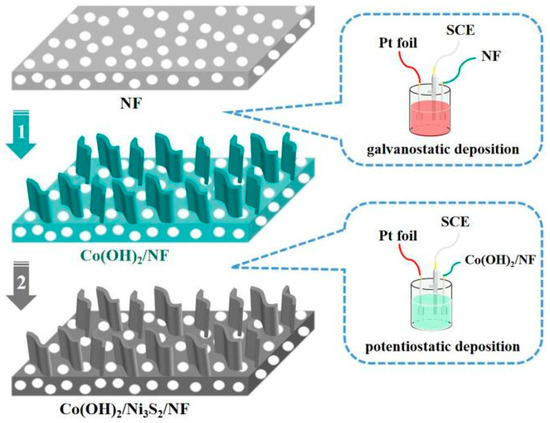
Scheme 1.
The synthesis route of Co(OH)2/Ni3S2 heterostructure.
Figure 1a shows the XRD spectrum of the sample generated by the first step of galvanostatic deposition, in which the two prominent well-defined peaks marked with circles come from the NF substrate (JCPDS No. 01-1258). The peaks marked with squares correspond to the (100), (102), (105), (108) and (110) planes of the hexagonal phase of α-Co(OH)2 (JCPDS No. 46-0605) [19]. Figure 1b is a low-magnification SEM image of the corresponding Co(OH)2. As can be seen from this figure, dense Co(OH)2 evenly covers the surface of the NF substrate. High-magnification images confirmed that these Co(OH)2 are irregular nanoflake structures with a smooth surface. These curved, silk-ribbon-like nanoflakes are interlaced with a thickness of ca. 10 nm (Figure 1c,d).
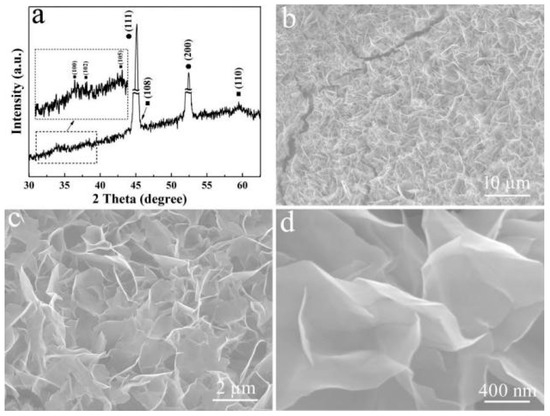
Figure 1.
(a) XRD pattern and (b–d) FE-SEM images of Co(OH)2 nanoflakes formed on NF.
The XRD spectrum of the sample after the second step of potentiostatic deposition is shown in Figure 2a. Except for the square (NF substrate) and circular (Co(OH)2) peaks, the diffraction peaks marked with an asterisk are attributed to the (100), (003), (021) and (122) crystalline planes of Ni3S2 (JCPDS card No. 44-1418), which confirms the formation of Ni3S2 on the surface of Co(OH)2 [12]. The SEM image in Figure 2b also confirms that these intertwined Co(OH)2 nanoflakes became significantly thicker due to the coating of Ni3S2. Figure 2c,d are corresponding enlarged images; it should be noted that the coated Ni3S2 also has the shape of curved nanoflakes with a thickness of ca. 5 nm. They are also intertwined with each other to form a network on the surface of Co(OH)2.
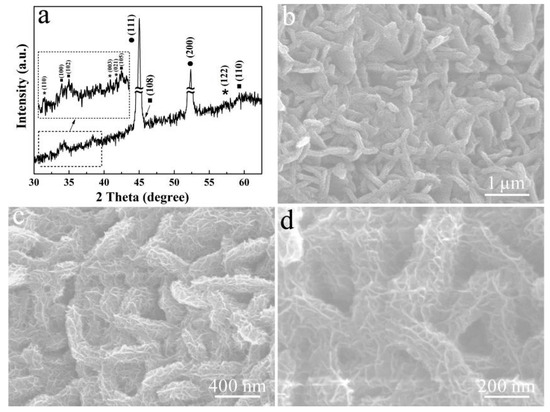
Figure 2.
(a) XRD pattern and (b–d) FE-SEM images of Co(OH)2/Ni3S2 heterostructure at different magnifications.
Figure 3 presents the XPS spectra of the Co(OH)2/Ni3S2 electrode. It is confirmed from the full spectrum that the sample contains Co, Ni, O and S elements (Figure 3a). The calibration is based on the C 1s peak at 284.8 eV (Figure 3b). As for the Co 2p spectrum in Figure 3c, two intense feature peaks situated at 798 and 781.3 eV correspond to Co 2p1/2 and Co 2p3/2. They all have corresponding satellite peaks located at 803.7 and 786.85 eV, which are indexed to the characteristic signatures of Co(OH)2 [15,20,21]. The Ni 2p spectrum is exhibited in Figure 3d. Two prominent peaks positioned at 874.26 and 856.60 eV can be assigned to Ni 2p1/2 and Ni 2p3/2 and a spin-orbit splitting of 17.7 eV, which confirms the existence of Ni2+ and Ni3+. The peaks at 880 and 861.7 eV are their satellite peaks [22,23]. In the O 1s spectrum (Figure 3e), the peak at 531.4 eV comes from hydroxyl oxygen in Co(OH)2 [14]. Figure 3f records the spectrum of S 2p, in which the intense main peak is composed of S 2p1/2 and S 2p3/2 at 163.3 and 162.1 eV, respectively, which arise from S2− [12]. In addition, a broad peak appears at 168.10 eV, which is ascribed to the S-O bond, and the oxygen comes from the hydroxyl groups produced by the hydrolysis of thiourea, as previously reported [24,25].
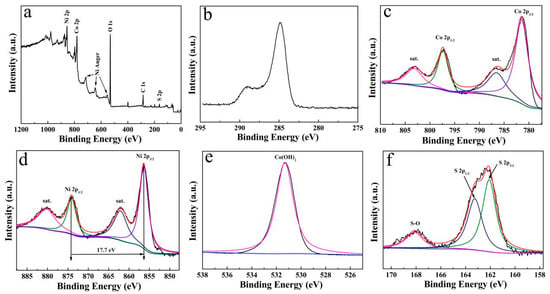
Figure 3.
XPS spectra of (a) survey scan; (b) C 1s; (c) Co 2p; (d) Ni 2p; (e) O 1s; (f) S 2p of Co(OH)2/Ni3S2 electrode.
In order to verify the effectiveness of the composite structure design, we compared the electrochemical behavior of Co(OH)2/Ni3S2, Ni3S2 and Co(OH)2 electrodes. Figure 4a presents the CV curves of the four electrodes at a scan rate of 10 mV s−1. A solution of 2 M NaOH was used as the electrolyte. Its function is to provide OH− for a reversible pseudocapacitance reaction with electrode materials, which also reflects the energy storage mechanism of pseudocapacitance materials. According to the rule, the larger the critical area of the CV curve, the higher the Cs [26]. It is evident that the Cs of the Co(OH)2/Ni3S2 electrode is significantly greater than the other three, and NF has almost no capacitance characteristics. The pseudocapacitive reactions involved are as follows [19,27]:
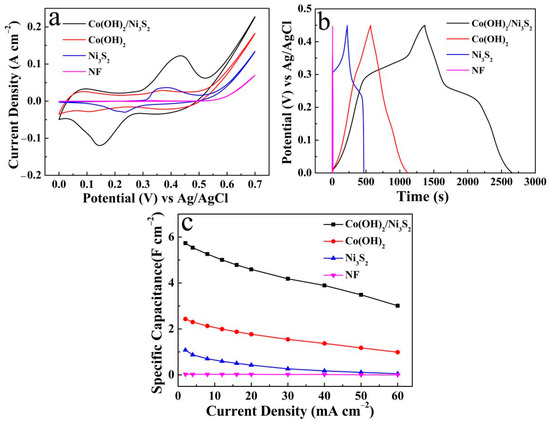
Figure 4.
Performance comparison of Co(OH)2/Ni3S2, Ni3S2, Co(OH)2 and NF electrodes: (a) CV curves, (b) GCD curves and (c) Cs at different current densities.
The above inference can also be confirmed from the GCD curve (2 mA cm−2) in Figure 4b on the premise of the same discharge current density: the longer the discharge time, the greater the Cs of the electrode [28]. Figure 4c also lists the Cs of the four electrodes at current densities of 2–60 mA cm−2, which fully confirms that the Cs of the Co(OH)2/Ni3S2 electrode was significantly enhanced compared with any single component. In fact, theoretically speaking, the more OH− that the electrolyte can provide, that is, the greater the electrolyte concentration, the more electrochemical active sites participating in the pseudocapacitance reaction, and the greater the Cs of the product. Therefore, the GCD curves of Co(OH)2/Ni3S2 composite at different NaOH concentrations, including 1, 2, 4 and 6 M, are compared in Figure S2a. With the increase in NaOH concentration, the discharge time of Co(OH)2/Ni3S2 gradually increases; therefore, Figure S2b shows a significantly enhanced trend of Cs. However, in our reaction system, we focus on comparing the difference in Cs between composite components and single components under the same test conditions. Therefore, we chose the 2 M NaOH electrolyte as an example for the electrochemical test and analysis.
In order to further evaluate the electrochemical properties of the composites and give full play to the supporting role of Co(OH)2 and its synergistic effect with Ni3S2, we systematically investigated the impact of the loading amount of Ni3S2 on the morphology and structure of the composite. When the deposition duration is 1 min, as shown in Figure 5a, the SEM image of the Co(OH)2/Ni3S2 composite at low magnification does not show a noticeable difference from pure Co(OH)2, which is also a curved flake structure. From the enlarged image in Figure 5b, it is found that the surface of these Co(OH)2 nanoflakes becomes rough due to the scattering of a large number of linear Ni3S2 particles. When the deposition reaches 10 min, it is evident from Figure 5c that these Co(OH)2 nanoflakes become thicker. After magnification, it is confirmed that these wrapped large amounts of Ni3S2 also begin to form a curved nanoflake structure, and the size is much smaller than that of Co(OH)2 (Figure 5d). As the deposition increases to 20 min, these nanoflakes gradually increase and become dense (Figure 5e), which is described in detail in Figure 2. When it extends to 40 min, the continuous excessive aggregation of Ni3S2 leads to disorderly accumulation and the destruction of the partial structures of Co(OH)2 (Figure 5f).
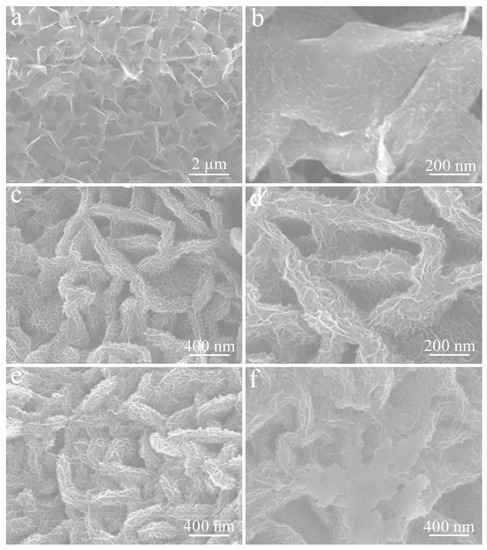
Figure 5.
FE-SEM images of Ni3S2 electrodeposited on Co(OH)2/NF for different potentiostatic deposition durations: (a,b) S-1, (c,d) S-10, (e) S-20 and (f) S-40.
Figure 6 compares the pseudocapacitance characteristics of the above four samples in 2 M NaOH solution. As seen in the CV curves in Figure 6a, the integral areas of the samples show an increasing trend with the increase in the potentiostatic deposition duration, except for S-40 because the necessary site of S-40 is almost the same as that of S-20. This trend is also reflected in Figure 6b. In order to distinguish these results in detail, Figure 6c lists the Cs values of four samples at current densities of 2–60 mA cm−2 according to the formula calculation [29]. The conclusion is that the Cs value is in the order of S-20 > S-10 > S-1 under the same current density. As for S-40, the Cs value is slightly greater than that of S-20 between 2 and 8 mA cm−2, while when the current density reaches 12 mA cm−2, the Cs value of S-40 is lower than that of S-20. Meanwhile, the rate capability of the four samples was deduced based on the sets of data [30]. S-20 is the largest, and its discharge Cs is still maintained at 52.53% when the current density increases from 2 to 60 mA cm−2. Figure 6d presents the voltage drop curves at current densities of 2–60 mA cm−2 of the four samples and the corresponding derived average RESR. The minimum RESR is S-20 with 1.35 Ω cm−2 according to the formula used [29].
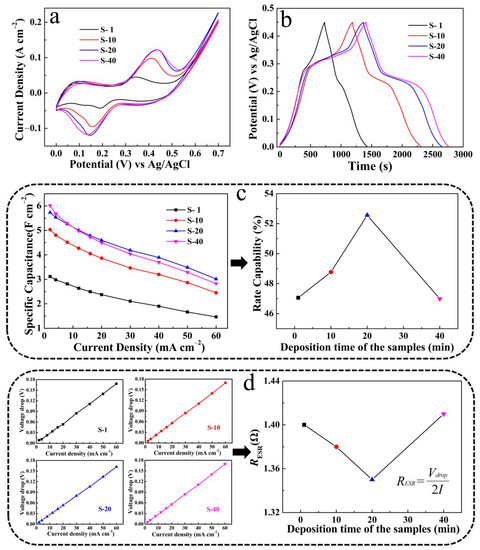
Figure 6.
Performance comparison of S-1, S-10, S-20 and S-40: (a) CV curves, (b) GCD curves, (c) Cs at different current densities and corresponding rate capabilities and (d) voltage drops at different current densities and corresponding average RESR.
According to the comparison and analysis of the above data, in addition to being the active component of the composite electrode, Co(OH)2 also provides support for the deposition of Ni3S2. At the same time, in general, the larger the loading amount of Ni3S2, the more active sites provided, and therefore, the more extensive the areal Cs [28], such as S-20 > S-10 > S-1. However, with the excessive aggregation of Ni3S2, the nanoflake structure of Co(OH)2 is completely covered or even destroyed (Figure 5f). These disorderly stacked Ni3S2 particles easily fall off in the charge–discharge process, resulting in decreases in Cs and rate capability, such as S-40. Additionally, excessive accumulation is bound to hinder the movement of ions and increase the average RESR [15]. Therefore, based on the relatively superior energy storage characteristics of S-20, it was further tested and systematically investigated.
Figure 7a shows the CV curves of the sample (S-20) in the scan rate range of 2–50 mV s−1. With the increase in the scan rate, the redox peaks move to a broader potential window, and the area surrounded by the CV curve gradually increases, but the corresponding Cs gradually decreases [9]. This is because the internal electrochemical active sites do not have enough time to fully react with the OH− in the electrolyte at high scan rates [15]. Figure 7b shows the GCD curves of the sample in the current density range of 2–60 mA cm−2. According to the formula, the lower the current density, the higher the discharge time and Cs [29]. At the same time, when the current density is 2 mA cm−2, the coulombic efficiency reaches 94.14% [31]. The calculated values of Cs are displayed in Figure 7c, which decrease from 5.73 to 3.01 F cm−2, corresponding to current density increases from 2 to 60 mA cm−2; that is, the Cs value can still be maintained at 52.53% of the initial value when the current density increases by 30 times, which reflects a relatively high rate performance. Figure 7d reveals the voltage drop curve at different current densities, and thus, the calculated average RESR is 1.35 Ω cm−2; these results are described in Figure 6c.
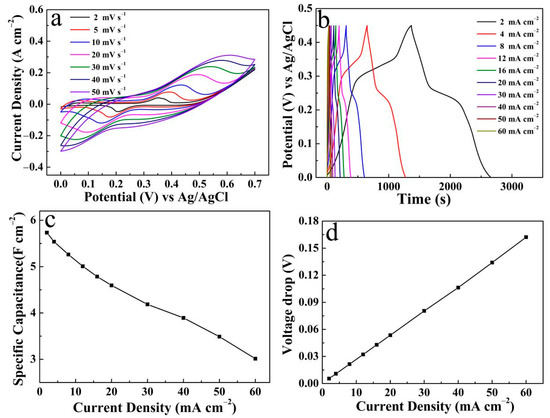
Figure 7.
(a) CV curves, (b) GCD curves, (c) Cs and (d) voltage drops at different current densities of Co(OH)2/Ni3S2 heterostructure (S-20).
As for single-component Co(OH)2 and Ni3S2 electrodes, their CV curves at scan rates of 2–50 mV s−1, GCD curves at current densities of 2–60 mA cm−2 and the corresponding Cs are also presented in Figure 8.
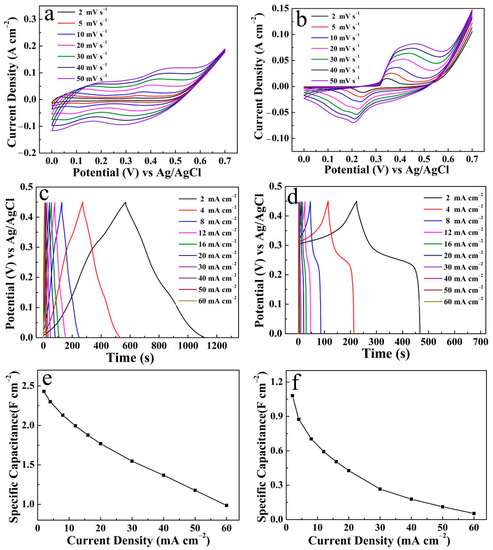
Figure 8.
CV curves, GCD curves and Cs at different current densities of Co(OH)2 (a,c,e) and Ni3S2 (b,d,f).
The Cs retention of the Co(OH)2/Ni3S2 electrode is presented in Figure 9. It can be observed that Cs reaches 90.63% at the 600th cycle and maintains the initial 84.38% within 5000 cycles.
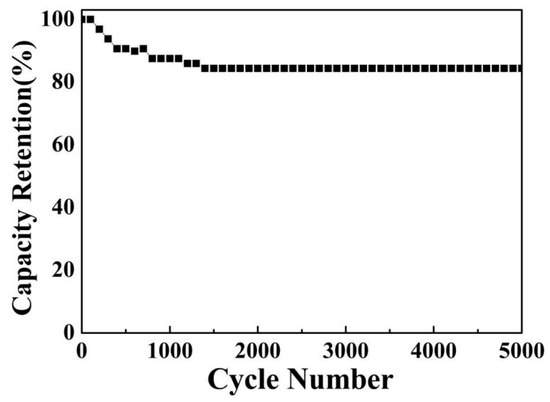
Figure 9.
Cycling performance of the Co(OH)2/Ni3S2 electrode.

Table 1.
Comparison of Cs of Cu(OH)2/Ni3S2 with reported in the literatures.
Table 1.
Comparison of Cs of Cu(OH)2/Ni3S2 with reported in the literatures.
| Electrode Materials | Electrode Substrate | Electrolyte | Current Density (mA cm−2) | Cs (F cm−2) | Literature |
|---|---|---|---|---|---|
| Co(OH)2/CoOOH/ Co3O4/Cu(OH)2 | Cu foam | 1 M KOH | 1 | 1.94 | [32] |
| Co(OH)2/Co9S8 | NiFe skeleton | 3 M KOH | 10 | 5.28 | [33] |
| Co9S8@Co(OH)2 | Ni foam | 3 M KOH | 1.5 | 5.62 | [13] |
| Co3S4-Ni3S2 | Ni foam | 6 M KOH | 2 | 2.83 | [34] |
| Ni3S2/rGO | Ni foam | 2 M KOH | 2 | 1.96 | [27] |
| Ni3S2/CoFeLDH | Ni foam | 1 M KOH | 2 | 5.08 | [35] |
| Cu(OH)2/Ni3S2 | Cu foam | 2 M NaOH | 2 | 4.85 | [10] |
| NiCoLDH@Ni3S2 | Ni foam | 3 M KOH | 3 | 4.95 | [36] |
| Co(OH)2/Ni3S2 | Ni foam | 2 M NaOH | 2 | 5.73 | Present work |
Table 1 shows several composite electrode materials reported in the recent literature with Co(OH)2 or Ni3S2 as components and their Cs. By comparison, the prepared Co(OH)2/Ni3S2 shows comparable or even more prominent properties than those previously reported. This is attributed to the selection of composite components and their preparation strategies, which are mainly reflected in the following aspects: (1) Co(OH)2 and Ni3S2 are regarded as the most promising electrode materials owing to their low cost, abundance and high theoretical Cs [22]. At the same time, it can be inferred that in our reaction system, both Co(OH)2 and Ni3S2 participate in the pseudocapacitive reaction as active components. In particular, the nanoflake structures of Co(OH)2 and Ni3S2 are favorable for fast pseudocapacitive reactions due to the reduced charge transportation pathways [12]. Meanwhile, these nanoflakes interweave with each other to form a network, which provides more channels for charge transportation. Therefore, the Co(OH)2/Ni3S2 heterostructure can deliver a robust synergistic effect, which is bound to improve the overall properties of the composite [18]. (2) The addition of Co(OH)2 also acts as a bridge between the electrode substrate and Ni3S2, which provides support for the deposition of Ni3S2 to form more abundant electrochemical active sites [18,37]. Meanwhile, the Co(OH)2 nanoflakes can effectively alleviate the collapse of the structure in the charge–discharge process [12]. (3) This in situ electrodeposition technology reflects the advantages of a short preparation cycle, easy regulation of the amount of deposited active substances, good stability, direct acquisition of the binder-free electrode to be measured and reduction in contact resistance [38].
4. Conclusions
In summary, we successfully synthesized a hierarchical Co(OH)2/Ni3S2 heterostructure on the NF substrate through the combination of galvanostatic and potentiostatic deposition. The introduction of Co(OH)2, as an electrochemically active component, provides support for the deposition of Ni3S2. Then, the optimal deposition amount of Ni3S2 is achieved by adjusting the deposition duration of Ni3S2. The Co(OH)2/Ni3S2 heterostructures thus obtained exhibited promising electrochemical characteristics with a high areal Cs of 5.73 F cm−2 at 2 mA cm−2, which remained 3.01 F cm−2 at 60 mA cm−2. The coulombic efficiency is excellent, reaching 94.14%, and the long-term cycle reversibility maintains the initial 84.38% within 5000 cycles. Furthermore, the present work provides some new inspiration for designing and developing efficient Co(OH)2- or Co3O4-based composite electrode materials for energy storage.
Supplementary Materials
The following supporting information can be downloaded at: https://www.mdpi.com/article/10.3390/pr10071255/s1. Figure S1: FE-SEM image of pristine NF; Figure S2: (a) GCD curves at 2 mA cm−2 and (b) Cs of Co(OH)2/Ni3S2 heterostructure at different NaOH concentrations.
Author Contributions
Conceptualization, H.W.; methodology, P.G.; software, J.Y.; formal analysis, X.C.; investigation, S.L. and Z.C.; writing—original draft preparation, W.S.; writing—review and editing, S.L. and X.Y.; supervision, Y.C.; funding acquisition, C.W. All authors have read and agreed to the published version of the manuscript.
Funding
This research was funded by The Scientific and Technology Development Project of Jilin Province, China (Grant No. 20200403137SF and 20210203098SF).
Institutional Review Board Statement
Not applicable.
Informed Consent Statement
Not applicable.
Data Availability Statement
Not applicable.
Conflicts of Interest
The authors declare no conflict of interest.
References
- Zhang, D.; Tan, C.; Ou, T.; Zhang, S.R.; Li, L.; Ji, X.H. Constructing advanced electrode materials for low-temperature lithium-ion batteries: A review. Energy Rep. 2022, 8, 4525–4534. [Google Scholar]
- Tomy, M.; Rajappan, A.A.; Vimuna, V.; Suryabai, X.T. Emergence of Novel 2D Materials for High-Performance Supercapacitor Electrode Applications: A Brief Review. Energy Fuel 2021, 35, 19881–19900. [Google Scholar] [CrossRef]
- Mone, P.; Deore, S.; Balgude, S.; Pandit, V. Fabrication, design and performance evaluation of supercapacitors review. Mater. Today Proc. 2022, 53, 130–133. [Google Scholar] [CrossRef]
- Patel, K.K.; Singhal, T.; Pandey, V.; Sumangala, T.P.; Sreekanth, M.S. Evolution and recent developments of high performance electrode material for supercapacitors: A review. J. Energy Storage 2021, 44, 103366. [Google Scholar] [CrossRef]
- Delbari, S.A.; Ghadimi, L.S.; Hadi, R.; Farhoudian, S.; Nedaei, M.; Babapoor, A.; Namini, A.S.; Le, Q.V.; Shokouhimehr, M.; Asl, M.S.; et al. Transition metal oxide-based electrode materials for flexible supercapacitors: A review. J. Alloys Compd. 2021, 857, 158281. [Google Scholar] [CrossRef]
- Gao, Y.; Zhao, L.J. Review on recent advances in nanostructured transition-metal-sulfide-based electrode materials for cathode materials of asymmetric supercapacitors. Chem. Eng. J. 2022, 430, 132745. [Google Scholar] [CrossRef]
- Miller, E.E.; Hua, Y.; Tezel, F.H. Materials for energy storage: Review of electrode materials and methods of increasing capacitance for supercapacitors. J. Energy Storage 2018, 20, 30–40. [Google Scholar] [CrossRef]
- Zhang, Y.; Mei, H.X.; Cao, Y.; Yan, X.H.; Yan, J.; Gao, H.L.; Luo, H.W.; Wang, S.W.; Jia, X.D.; Kachalova, L.; et al. Recent advances and challenges of electrode materials for flexible supercapacitors. Coordin. Chem. Rev. 2021, 438, 213910. [Google Scholar] [CrossRef]
- Satpathy, B.K.; Patnaik, S.; Pradhan, D. Room-Temperature Growth of Co(OH)2 Nanosheets on Nanobelt-like Cu(OH)2 Arrays for a Binder-Free High-Performance All-Solid-State Supercapacitor. ACS Appl. Energy Mater. 2022, 1, 77–87. [Google Scholar] [CrossRef]
- Lv, S.; Shang, W.S.; Wang, H.; Chu, X.F.; Chi, Y.D.; Wang, C.; Yang, J.; Geng, P.Y.; Yang, X.T. Design and Construction of Cu(OH)2/Ni3S2 Composite Electrode on Cu Foam by Two-Step Electrodeposition. Micromachines 2022, 13, 237. [Google Scholar] [CrossRef]
- Huang, J.; Wei, J.C.; Xiao, Y.B.; Xu, Y.Z.; Xiao, Y.J.; Wang, Y.; Tan, L.C.; Yuan, K.; Chen, Y.W. When Al-Doped Cobalt Sulfide Nanosheets Meet Nickel Nanotube Arrays: A Highly Efficient and Stable Cathode for Asymmetric Supercapacitors. ACS Nano 2018, 12, 3030–3041. [Google Scholar] [CrossRef] [PubMed]
- Wang, J.S.; Hu, L.B.; Zhou, X.Y.; Zhang, S.; Qiao, Q.S.; Xu, L.; Tang, S.C. Three-Dimensional Porous Network Electrodes with Cu(OH)2 Nanosheet/Ni3S2 Nanowire 2D/1D Heterostructures for Remarkably Cycle-Stable Supercapacitors. ACS Omega 2021, 6, 34276–34285. [Google Scholar] [CrossRef] [PubMed]
- Zheng, L.X.; Ye, W.Q.; Yang, P.J.; Song, J.L.; Shi, X.W.; Zheng, H.J. Manganese doping to boost the capacitance performance of hierarchical Co9S8@Co(OH)2 nanosheet arrays. Green Energy Environ. 2021; in press. [Google Scholar] [CrossRef]
- Yu, Z.Y.; Cheng, Z.X.; Wang, X.L.; Dou, S.X.; Kong, X.Y. High area-specific capacitance of Co(OH)2/hierarchical nickel/nickel foam supercapacitors and its increase with cycling. J. Mater. Chem. A 2017, 5, 7968–7978. [Google Scholar] [CrossRef]
- Maile, N.C.; Shinde, S.K.; Koli, R.R.; Fulari, A.V.; Kim, D.Y.; Fulari, V.J. Effffect of difffferent electrolytes and deposition time on the supercapacitor properties of nanoflflake-like Co(OH)2 electrodes. Ultrason. Sonochem. 2019, 51, 49–57. [Google Scholar] [PubMed]
- Li, R.; Wang, S.L.; Huang, Z.C.; Lu, F.X.; He, T.B. NiCo2S4@Co(OH)2 core-shell nanotube arrays in situ grown on Ni foam for high performances asymmetric supercapcitors. J. Power Sources 2016, 312, 156–164. [Google Scholar] [CrossRef]
- Dileep, N.P.; Vineesh, T.V.; Sarma, P.V.; Chalil, M.V.; Prasad, C.S.; Shaijumon, M.M. Electrochemically Exfoliated β-Co(OH)2 Nanostructures for Enhanced Oxygen Evolution Electrocatalysis. ACS Appl. Energy Mater. 2020, 3, 1461–1467. [Google Scholar] [CrossRef]
- Wang, Y.; Yin, Z.L.; Wang, Z.X.; Li, X.H.; Guo, H.J.; Jiexi Wang, J.X.; Zhang, D.C. Facile construction of Co(OH)2@Ni(OH)2 core-shell nanosheets on nickel foam as three dimensional free-standing electrode for supercapacitors. Electrochim. Acta 2019, 293, 40–46. [Google Scholar] [CrossRef]
- He, D.; Wan, J.N.; Liu, G.L.; Suo, H.; Zhao, C. Design and construction of hierarchical α-Co(OH)2-coated ultra-thin ZnO flower nanostructures on nickel foam for high performance supercapacitors. J. Alloys Compd. 2020, 838, 155556–155564. [Google Scholar] [CrossRef]
- Tang, S.S.; Li, X.G.; Courté, M.; Peng, J.J.; Fichou, D. Hierarchical Cu(OH)2@Co(OH)2 Nanotrees for Water Oxidation Electrolysis. ChemCatChem 2020, 12, 4038–4043. [Google Scholar] [CrossRef]
- Guo, W.W.; Kim, J.; Kim, H.; Han, G.H.; Jang, H.W.; Kim, S.Y.; Sang Hyun Ahn, S.H. Sandwich-like Co(OH)x/Ag/Co(OH)2 nanosheet composites for oxygen evolution reaction in anion exchange membrane water electrolyzer. J. Alloys Compd. 2021, 889, 161674. [Google Scholar] [CrossRef]
- Chen, F.S.; Wang, H.; Ji, S.; Linkov, V.; Wang, R.F. Core-shell structured Ni3S2@Co(OH)2 nano-wires grown on Ni foam as binder-free electrode for asymmetric supercapacitors. Chem. Eng. J. 2018, 345, 48–57. [Google Scholar] [CrossRef]
- Wang, X.L.; Jin, E.M.; Chen, J.S.; Bandyopadhyay, P.; Jin, B.; Jeong, S.M. Facile In Situ Synthesis of Co(OH)2-Ni3S2 Nanowires on Ni Foam for Use in High-Energy-Density Supercapacitors. Nanomaterials 2022, 12, 34. [Google Scholar] [CrossRef] [PubMed]
- Liu, Y.Q.; Yu, Y.; Mu, Z.C.; Wang, Y.H.; Usman, A.; Jing, S.Y.; Xing, S.X. Urea-assisted enhanced electrocatalytic activity of MoS2-Ni3S2 for overall water splitting. Inorg. Chem. Front. 2020, 7, 3588–3597. [Google Scholar] [CrossRef]
- Fu, S.Q.; Yang, X.C.; Zhao, P.D.; Yao, X.; Jiao, Z.; Cheng, L.L. Regulable Electron Transfer on ZnS/CoS2/CC Prepared by an MOF-on-MOF Strategy for Robust LIB Performance. ACS Appl. Energy Mater. 2022, 5, 5159–5169. [Google Scholar] [CrossRef]
- Ding, J.F.; Zhao, D.P.; Xia, T.; Xia, Q.; Li, G.L.; Qu, Y.D. Hierarchical Co3O4@Ni3S2 electrode materials for energy storage and conversion. Dalton Trans. 2022, 51, 4704–4711. [Google Scholar] [CrossRef] [PubMed]
- Miao, J.H.; Wu, D.J.; Gao, X.R.; Wang, W.; Wu, W.P.; Tao, S.; Fang, Y.; Han, Z.D.; Qian, B.; Jiang, X.F.; et al. Ni3S2/rGO nanoparticles ensemble by an in-situ microwave irradiation route for supercapacitors. J. Alloys Compd. 2021, 890, 161435. [Google Scholar] [CrossRef]
- Pan, X.B.; Zhao, L.J.; Liu, H.B.; Guo, M.Y.; Han, C.D.; Wang, W.Q. Hierarchical structure Ni3S2/Ni(OH)2 nanoarrays towards high-performance supercapacitors. J. Solid State Chem. 2022, 309, 122974. [Google Scholar] [CrossRef]
- Liu, G.L.; He, X.; He, D.; Cui, B.Y.; Zhu, L.; Suo, H. Construction of CuO@Ni-Fe layered double hydroxide hierarchical core-shell nanorods arrays on copper foam for high-performance Supercapacitors. J. Mater. Sci. Mater. Electron. 2019, 30, 2080–2088. [Google Scholar] [CrossRef]
- An, Q.; Sun, X.H.; Guo, J.Z.; Cai, S.; Zheng, C.M. Review-Key Strategies to Increase the Rate Capacity of Cathode Materials for High Power Lithium-Ion Batteries. J. Electrochem. Soc. 2020, 167, 140528. [Google Scholar] [CrossRef]
- Liu, G.L.; Zhao, C.; Liu, T.Y.; He, D.; Suo, H. Facile route to achieve book-like tricobalt tetraoxide microstructures on copper foam for high performance supercapacitor. Mater. Lett. 2018, 220, 78–81. [Google Scholar] [CrossRef]
- Yu, Y.W.; Wang, H.M.; Zhang, H.Z.; Tan, Y.R.; Wang, Y.L.; Song, K.F.; Yang, B.Q.; Yuan, L.F.; Shen, X.D.; Hu, X.L. Blanket-like Co(OH)2/CoOOH/Co3O4/Cu(OH)2 composites on Cu foam for hybrid supercapacitor. Electrochim. Acta 2020, 334, 135559. [Google Scholar] [CrossRef]
- Wu, B.X.; Zhang, F.F.; Nie, Z.W.; Qian, H.; Liu, P.; He, H.; Wu, J.H.; Chen, Z.Y.; Chen, S.G. A high-performance battery-like supercapacitor electrode with a continuous NiTe network skeleton running throughout Co(OH)2/Co9S8 nanohybrid. Electrochim. Acta 2021, 365, 137325. [Google Scholar] [CrossRef]
- Li, Z.L.; Ren, J.; Yang, C.M.; He, Y.X.; Liang, Y.; Liu, J.L.; Waterhouse, G.I.N.; Li, J.H.; Qian, D. Sodium 5-sulfosalicylate-assisted hydrothermal synthesis of a selfsupported Co3S4-Ni3S2@nickel foam electrode for all-solid-state asymmetric supercapacitors. J. Alloys Compd. 2021, 889, 161661. [Google Scholar]
- Wang, Y.X.; Zhang, W.J.; Guo, X.L.; Liu, Y.Y.; Zheng, Y.M.; Zhang, M.; Li, R.; Peng, Z.B.; Zhao, Y.H. Construction of high-performance asymmetric supercapacitor based on the hierarchical Ni3S2/CoFe LDH/Ni foam hybrid. Appl. Surf. Sci. 2021, 561, 150049. [Google Scholar] [CrossRef]
- Wen, J.; Li, S.Z.; Chen, T.; Yue, Y.; Liu, N.S.; Gao, Y.H.; Li, B.R.; Song, Z.C.; Xiong, L.B.; Chen, Z.; et al. Three-dimensional hierarchical NiCo hydroxide@Ni3S2 nanorod hybrid structure as high performance positive material for asymmetric supercapacitor. Electrochim. Acta 2016, 222, 965–975. [Google Scholar] [CrossRef]
- Dong, X.; Wang, M.T.; He, L.Q.; Hu, P.; Wang, H.; Zhang, Z.H.; Huang, Z.L.; Shang, C.Q. Ternary Co-Ni sulfides deposited on Co(OH)2 nanoflakes decorated carbon cloth as electrode for supercapacitor. Inorg. Chem. Commun. 2022, 140, 109443. [Google Scholar]
- Liang, H.Y.; Lin, T.S.; Wang, S.Y.; Jia, H.N.; Li, C.; Cao, J.; Feng, J.C.; Fei, W.D.; Qi, J.L. A free-standing manganese cobalt sulfifide@cobalt nickel layered double hydroxide core-shell heterostructure for an asymmetric supercapacitor. Dalton Trans. 2020, 49, 196. [Google Scholar] [CrossRef]
Publisher’s Note: MDPI stays neutral with regard to jurisdictional claims in published maps and institutional affiliations. |
© 2022 by the authors. Licensee MDPI, Basel, Switzerland. This article is an open access article distributed under the terms and conditions of the Creative Commons Attribution (CC BY) license (https://creativecommons.org/licenses/by/4.0/).